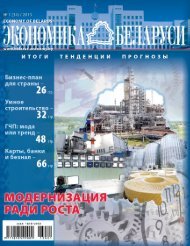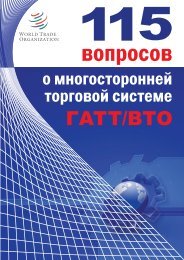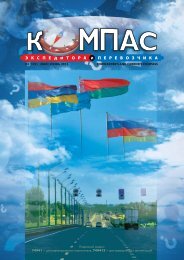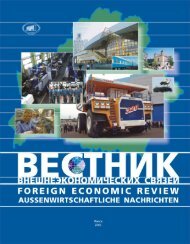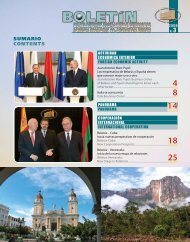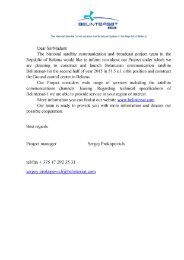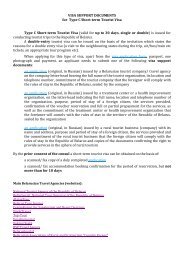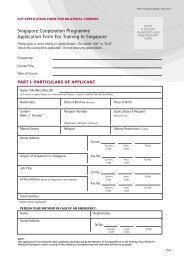Having weathered theAsian financial crisisin 1997, Indonesiatoday stands out foreffectively managingits commodity exports• Republic of Korea. When the Republic ofKorea and some of the other East Asianeconomies went through a phase of moderateimport substitution for consumergoods, they did not protect domestic producersof capital goods. 70 Even when theywere ambivalent about FDI in the 1980s,they chose to import technology underlicensing agreements and to develop linkswith multinational firms. The goal was tobuild indigenous capabilities for the longhaul by borrowing and assimilating foreigntechnologies.• Thailand. Thailand’s manufacturing prowesscontinues to strengthen through the country’sparticipation in international productionnetworks. In 2009–2010, its exportsof parts and components—notably in theautomotive and electronics industries—werevalued at $48 billion, a quarter of its merchandiseexports. The government is keen toestablish Thailand as the “Detroit of Asia”,not only a cluster for logistics, but also ahigh-tech hub that forges research collaborationamong firms, universities and the publicsector. 71• Malaysia. Malaysia’s pre-eminence in theelectronics industry began in the early daysof the international division of labour, withits courting of multinational companies fromcountries in the North. Free trade zones,established primarily for manufacturing electronicgoods, 72 helped the country developrapidly between the 1970s and the 1990s.Today, however, Malaysia’s economy is seento be in a “middle-income trap”, no longerable to compete with low-cost productionin neighbouring countries and lacking theskills for high-end tasks in global productionnetworks. 73 The government’s own advisorycouncil is concerned that a slowdown in FDIinflows could affect the prospects for graduatingto high-income status. 74 Malaysia’s goodrecord in secondary education does not seemto have produced a strong enough base foran innovation-driven economy: Malaysia’sfuture progress is hampered by inadequateresearch and development capacity and a lackof design and process engineers and technicaland production workers. 75• Indonesia. In the 1990s, to avoid the highcosts associated with aspects of protection,Indonesia and some other East Asian countriesestablished export processing zones,bonded warehouses and duty drawbacksystems—all requiring a competent bureaucracy.When countries felt they lacked thatcapacity, they resorted to unconventionalapproaches. For a period Indonesia evenprivatized its customs administration. 76Having weathered the Asian financialcrisis in 1997, Indonesia today stands outfor effectively managing its commodityexports. 77Piggybacking on niche productsOne option for smaller economies is to tap intoworld markets for niche products. The choiceof successful products is not accidental; it isoften the result of years of state support andfacilitation that build on existing competenciesor the creation of new ones.• Chile. With active support from the state,Chilean firms have had major success inexpanding exports of processed agriculturalfood and beverages and forestry andfish products. For example, in the 1960s,there was substantial public research anddevelopment in the cultivation of grapesfor wine production. There has also beena long history of subsidized plantations inforestry, and the state has made major effortsto turn the wood, pulp and paper, andfurniture cluster into a major export industry.78 Similar support from a nonprofitcorporation, Fundación Chile, has helpedmake the country’s commercial salmoncultivation one of the most prolific in theworld. 79• Bangladesh. Bangladesh took advantage ofmarket distortions in world apparel trade. 80But without the initiative of its entrepreneurs,it could easily have squandered theopportunity. In 1978, the Desh Companysigned a five-year collaboration agreementwith Daewoo, a Korean company, that connectedBangladesh to international standardsand a network of apparel buyers. Daewootrained Desh employees in production andmarketing in the Republic of Korea. Withina year, 115 of the 130 trainees had left Deshto start their own garment export firms. 81 By2010, Bangladesh’s share of world apparel76 | HUMAN DEVELOPMENT REPORT <strong>2013</strong>
exports had increased to about 4.8%, fromabout 0.8% in 1990. 82• Mauritius. With limited arable land, anexpanding population and overreliance onone commodity (sugar), Mauritius had toseek a larger, overseas market. Asian garmentexporters, constrained by quotas, wereattracted to the country. Until the 1990s,Mauritius was one of the most protectedeconomies, but it provided duty-free accessto imported inputs, tax incentives and flexiblelabour market conditions, includingsupporting the entry of women into labour-intensivejobs in the export processingzones. 83• Ghana. Cocoa has been at the heart ofGhana’s economy for decades. In the 1970sand early 1980s, however, the sector facednear-collapse. Ghana restored its internationalcompetitiveness with reforms begunin 1983, especially by devaluing the currency,increasing the capacity of the privatesector in procurement and marketing, andgiving farmers a much higher share of pricesreceived. Between 1983 and 2006, thecountry doubled its production of cocoaper hectare, and today the sector supportsthe livelihoods of 700,000 people. 84 Overthe past 10 years, Ghana has also diversifiedinto services, with the telecom sectorgrowing fast and augmenting the capacityof farmers to connect to sources of marketinformation. A recent survey found thataround 61% of cocoa farmers owned mobilephones. 85A common thread that runs through theeconomies that have had meaningful engagementwith the world is their investment inpeople. Tariff reform, at home or in partnercountries, may provide an unexpected openinginto export markets; some countriesmay enjoy resource windfalls or ride a waveof short-term success by mimicking others.However, the lesson is that developmentcannot be sustained without adequate investmentin people’s skills to constantly upgradethe quality of products and production techniques.The countries discussed here beganfrom diverse initial conditions and havebecome adept at tailoring nurtured domesticstrengths to reap external opportunitiespresented by world markets.Driver 3: determined socialpolicy innovationEvidence shows that substantial publicinvestment—effectively deployed not justin infrastructure, but also in health andeducation—is key to achieving and sustaininghuman development. <strong>Development</strong> strategiescannot succeed without a commitment toequality of opportunity, giving everyone a fairchance to enjoy the fruits of growth. Indeed,there is strong multicountry evidence that promotinghigher human development levels helpsaccelerate economic growth. 86A good test of a government’s commitmentto equality of opportunity is its determinationto provide education, particularly to girls.Countries that have sustained high long-termgrowth have generally put considerable effortinto educating their citizens and deepeninghuman capital. 87 Investing in education isimportant for improving cognitive skills, asmeasured by the performance of students onmathematics and science tests. 88 However, thebenefits derive from investment not so muchin the production of specialist skills but in“education for all”. 89 Similarly, improvementsin public health help growth by boosting labourproductivity. 90Growth accompanied by high or rising inequalitygenerally involves slower advances inhuman development, poor social cohesion andslow reduction in poverty. Moreover, it is usuallyconsidered unsustainable. 91 Thus the aimshould be to create virtuous cycles in whichgrowth and social policies reinforce each other.Growth has frequently been much more effectiveat reducing poverty in countries with lowincome inequality than in countries with highincome inequality. Growth is also less effectivein reducing poverty when the distribution ofincome worsens over time. 92The exceptions seem to be China and Brazil.Over the last 30 years, as a result of very highrates of growth, China has reduced povertydespite increasing income inequality. Similarly,in the early 2000s, Brazil used targetedpolicies to reduce poverty despite high incomeinequality—though income distribution becamemore equal over this period.Promoting equality—especially equalityacross groups, known as horizontal<strong>Development</strong> strategiescannot succeed withouta commitment to equalityof opportunity, givingeveryone a fair chance toenjoy the fruits of growthChapter 3 Drivers of development transformation | 77
- Page 1 and 2:
WNSEHuman DevelopmentReport 2013The
- Page 3 and 4:
Human Development Report 2013The Ri
- Page 5 and 6:
Human Development Report 2013 TeamD
- Page 7 and 8:
Finally, the Report also calls for
- Page 9 and 10:
Heather Simpson, Ben Slay, Mounir T
- Page 11 and 12:
3.6 India’s Supreme Court issues
- Page 13 and 14:
OverviewOne of the most heartening
- Page 15 and 16:
and sustainability are fully incorp
- Page 17 and 18:
Without investment in people, retur
- Page 19 and 20:
opportunity to reap the full benefi
- Page 21 and 22:
Woods institutions, the United Nati
- Page 23 and 24:
IntroductionWhen developed economie
- Page 25 and 26:
leading economies—Brazil, China a
- Page 27 and 28:
comparable access to information, e
- Page 29 and 30:
mobile phones: cellular banking is
- Page 32 and 33:
“The political problem ofmankind
- Page 34 and 35:
BOX 1.1Fairness, macroeconomics and
- Page 36 and 37:
BOX 1.3Amartya Sen, Nobel Laureate
- Page 38 and 39: FIGURE 1.1Income per capita is risi
- Page 40 and 41: BOX 1.4Subjective indicators of wel
- Page 42 and 43: FIGURE 1.4There is notable variatio
- Page 44 and 45: FIGURE 1.6Most regions show declini
- Page 46 and 47: Progress in humandevelopment achiev
- Page 48 and 49: BOX 1.7Social competencies: human d
- Page 50 and 51: TABLE 1.3Inequality and satisfactio
- Page 52 and 53: Not all countries havethe precondit
- Page 54 and 55: “When the music changes,so does t
- Page 56 and 57: BOX 2.1The South’s integration wi
- Page 58 and 59: FIGURE 2.1As a share of world merch
- Page 60 and 61: BOX 2.2Acquisitions by the South of
- Page 62 and 63: FIGURE 2.3Between 2000 and 2010, In
- Page 64 and 65: FIGURE 2.4Export earnings per capit
- Page 66 and 67: BOX 2.6Final assembly is about more
- Page 68 and 69: Instead of having a centreof indust
- Page 70 and 71: FIGURE 2.6Emerging market economies
- Page 72 and 73: Developing countriestrade more amon
- Page 74 and 75: “We cannot expect thatall nations
- Page 76 and 77: TABLE 3.1Selected developing countr
- Page 78 and 79: A common featureof countries thatha
- Page 80 and 81: More important thangetting prices r
- Page 82 and 83: BOX 3.5Eastern Europe and Central A
- Page 84 and 85: States have to beconscious that the
- Page 86 and 87: As countries develop,they tend to d
- Page 90 and 91: Providing publicservices that contr
- Page 92 and 93: Advancing health requiresmore than
- Page 94 and 95: Universal public healthand educatio
- Page 96 and 97: • China. The Minimum Livelihood G
- Page 98 and 99: “Each generation will reap whatth
- Page 100 and 101: concerns will make for a complex en
- Page 102 and 103: A greater emphasison education cans
- Page 104 and 105: FIGURE 4.1Under the fast track scen
- Page 106 and 107: Around the worldpeople are calling
- Page 108 and 109: FIGURE 4.4Different environmental s
- Page 110 and 111: FIGURE 4.5Education policies can al
- Page 112 and 113: BOX 4.2China and Ghana: who benefit
- Page 114 and 115: FIGURE 4.8countries thus converge t
- Page 116 and 117: “Let us join hands to try tocreat
- Page 118 and 119: Areas of globalinternational concer
- Page 120 and 121: Addressing climatechange requires t
- Page 122 and 123: International governanceis increasi
- Page 124 and 125: BOX 5.2Jo Leinen, Member of the Eur
- Page 126 and 127: facilitates reserve investments and
- Page 128 and 129: Responsible sovereigntytakes the lo
- Page 130 and 131: FIGURE 5.1Under the accelerated pro
- Page 132 and 133: Good policymakingrequires greater f
- Page 134 and 135: A fair and less unequalworld requir
- Page 137 and 138: NotesOverview1 Atsmon and others 20
- Page 139 and 140:
25 Blinder 2006.26 UNIDO 2009.27 UN
- Page 141 and 142:
which is 61.7 deaths per 1,000 live
- Page 143 and 144:
ReferencesAbdurazakov, A., A. Minsa
- Page 145 and 146:
urban_world_cities_and_the_rise_of_
- Page 147 and 148:
Kamau, P., D. McCormick, and N. Pin
- Page 149 and 150:
Labor Administration. Geneva: Inter
- Page 151 and 152:
Human Development Report 2013The Ri
- Page 153 and 154:
Statistical acknowledgementsThe Rep
- Page 155 and 156:
Key to HDI countries and ranks, 201
- Page 157 and 158:
Human Development Report 2013The Ri
- Page 159 and 160:
Human Development Report 2013The Ri
- Page 161 and 162:
Human Development Report 2013The Ri
- Page 163 and 164:
Human Development Report 2013The Ri
- Page 165 and 166:
Human Development Report 2013The Ri
- Page 167 and 168:
Human Development Report 2013The Ri
- Page 169 and 170:
Human Development Report 2013The Ri
- Page 171 and 172:
Human Development Report 2013The Ri
- Page 173 and 174:
Human Development Report 2013The Ri
- Page 175 and 176:
Human Development Report 2013The Ri
- Page 177 and 178:
Human Development Report 2013The Ri
- Page 179 and 180:
Human Development Report 2013The Ri
- Page 181 and 182:
Human Development Report 2013The Ri
- Page 183 and 184:
Human Development Report 2013The Ri
- Page 185 and 186:
Human Development Report 2013The Ri
- Page 187 and 188:
Human Development Report 2013The Ri
- Page 189 and 190:
Human Development Report 2013The Ri
- Page 191 and 192:
Human Development Report 2013The Ri
- Page 193 and 194:
Human Development Report 2013The Ri
- Page 195 and 196:
Human Development Report 2013The Ri
- Page 197 and 198:
Human Development Report 2013The Ri
- Page 199 and 200:
Human Development Report 2013The Ri
- Page 201 and 202:
Human Development Report 2013The Ri
- Page 203 and 204:
Human Development Report 2013The Ri
- Page 205 and 206:
Human Development Report 2013The Ri
- Page 207 and 208:
Human Development Report 2013The Ri
- Page 209 and 210:
Human Development Report 2013The Ri
- Page 211 and 212:
Statistical referencesADB (Asian De
- Page 213 and 214:
Core features of the model pertinen
- Page 215 and 216:
Countries and HDI ranks in 2012 and



